SME Management: Analyzing Growth and Challenges at MRT Castings Ltd
VerifiedAdded on 2024/05/30
|16
|4908
|181
Case Study
AI Summary
This case study analyzes MRT Castings Ltd, a steel carving company, to understand the dynamics of managing small and medium-sized enterprises (SMEs). It highlights the importance of government support in addressing business challenges and explores alternative growth and development methods for SMEs. The study acknowledges challenges such as consumer expectations, technical advancements, and increased competition but emphasizes the benefits of government assistance in fostering growth. MRT Castings, established in 1947, serves as a practical example, showcasing its growth from a small family-owned business to a global manufacturer. The company's strategic investments, focus on innovation, and expansion into new markets, including defense and medical applications, demonstrate key factors in SME success. The case also touches upon the competitive landscape, the role of SMEs in the UK economy, and the challenges they face in globalization and technological advancements.
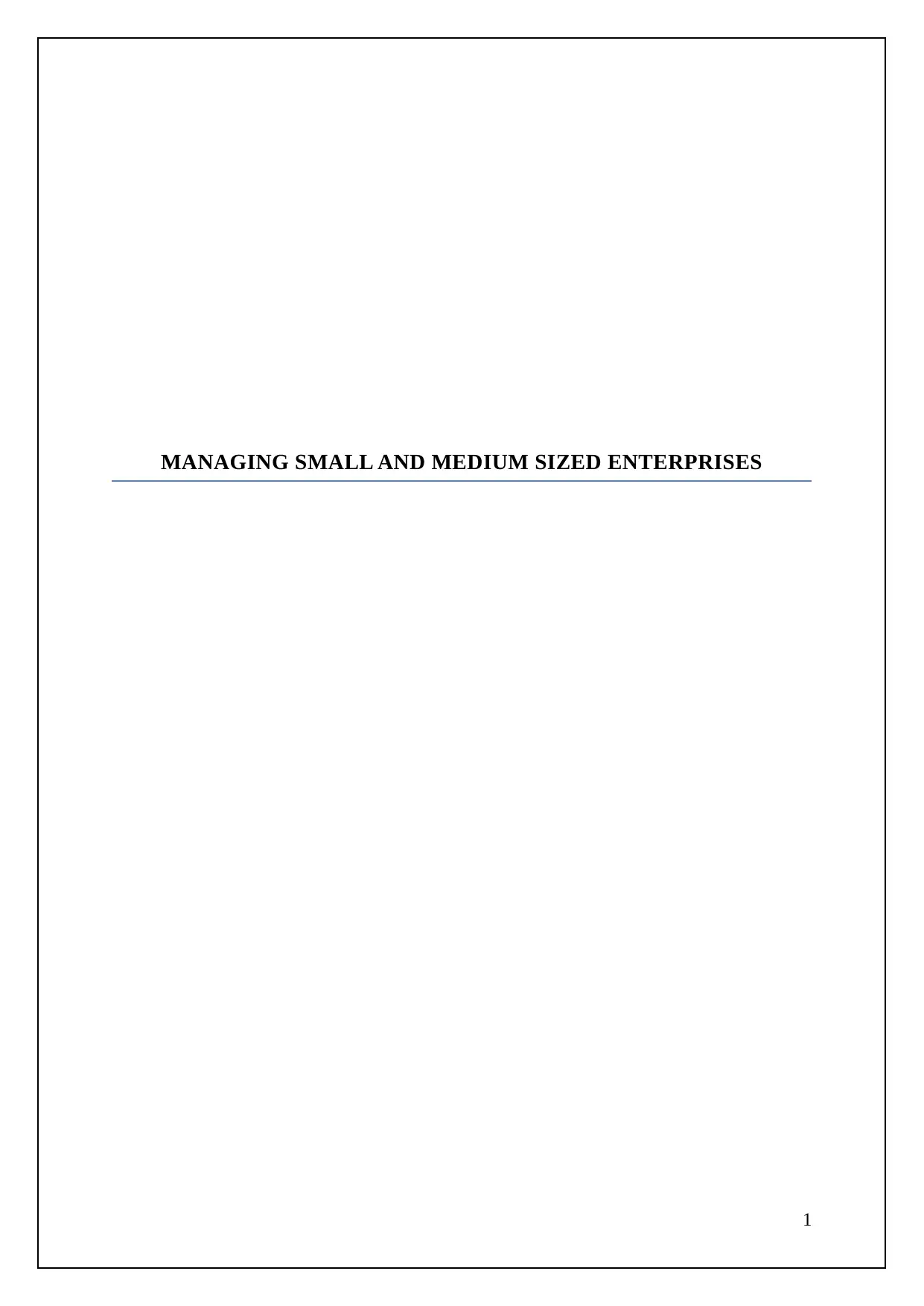
MANAGING SMALL AND MEDIUM SIZED ENTERPRISES
1
1
Paraphrase This Document
Need a fresh take? Get an instant paraphrase of this document with our AI Paraphraser
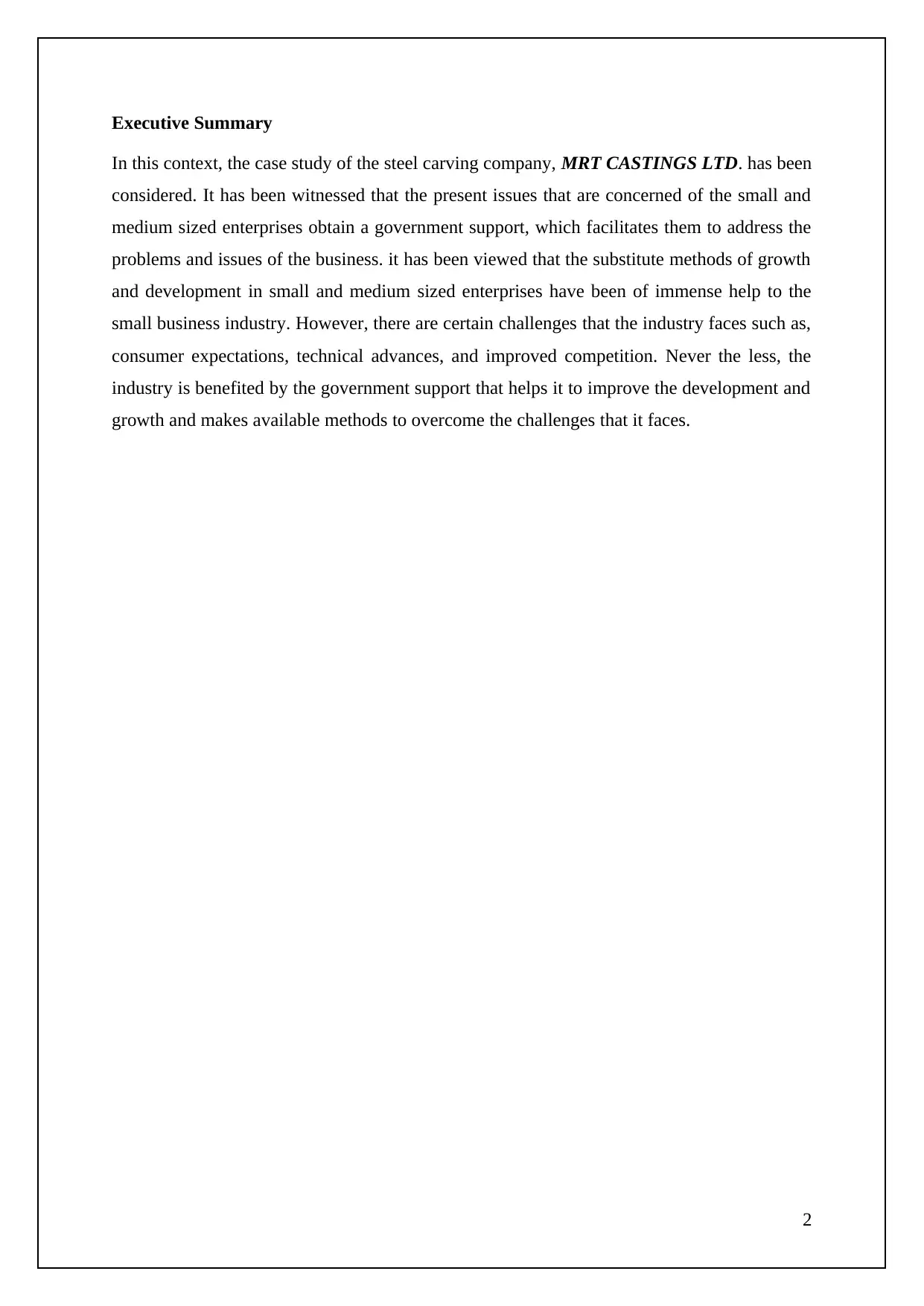
Executive Summary
In this context, the case study of the steel carving company, MRT CASTINGS LTD. has been
considered. It has been witnessed that the present issues that are concerned of the small and
medium sized enterprises obtain a government support, which facilitates them to address the
problems and issues of the business. it has been viewed that the substitute methods of growth
and development in small and medium sized enterprises have been of immense help to the
small business industry. However, there are certain challenges that the industry faces such as,
consumer expectations, technical advances, and improved competition. Never the less, the
industry is benefited by the government support that helps it to improve the development and
growth and makes available methods to overcome the challenges that it faces.
2
In this context, the case study of the steel carving company, MRT CASTINGS LTD. has been
considered. It has been witnessed that the present issues that are concerned of the small and
medium sized enterprises obtain a government support, which facilitates them to address the
problems and issues of the business. it has been viewed that the substitute methods of growth
and development in small and medium sized enterprises have been of immense help to the
small business industry. However, there are certain challenges that the industry faces such as,
consumer expectations, technical advances, and improved competition. Never the less, the
industry is benefited by the government support that helps it to improve the development and
growth and makes available methods to overcome the challenges that it faces.
2
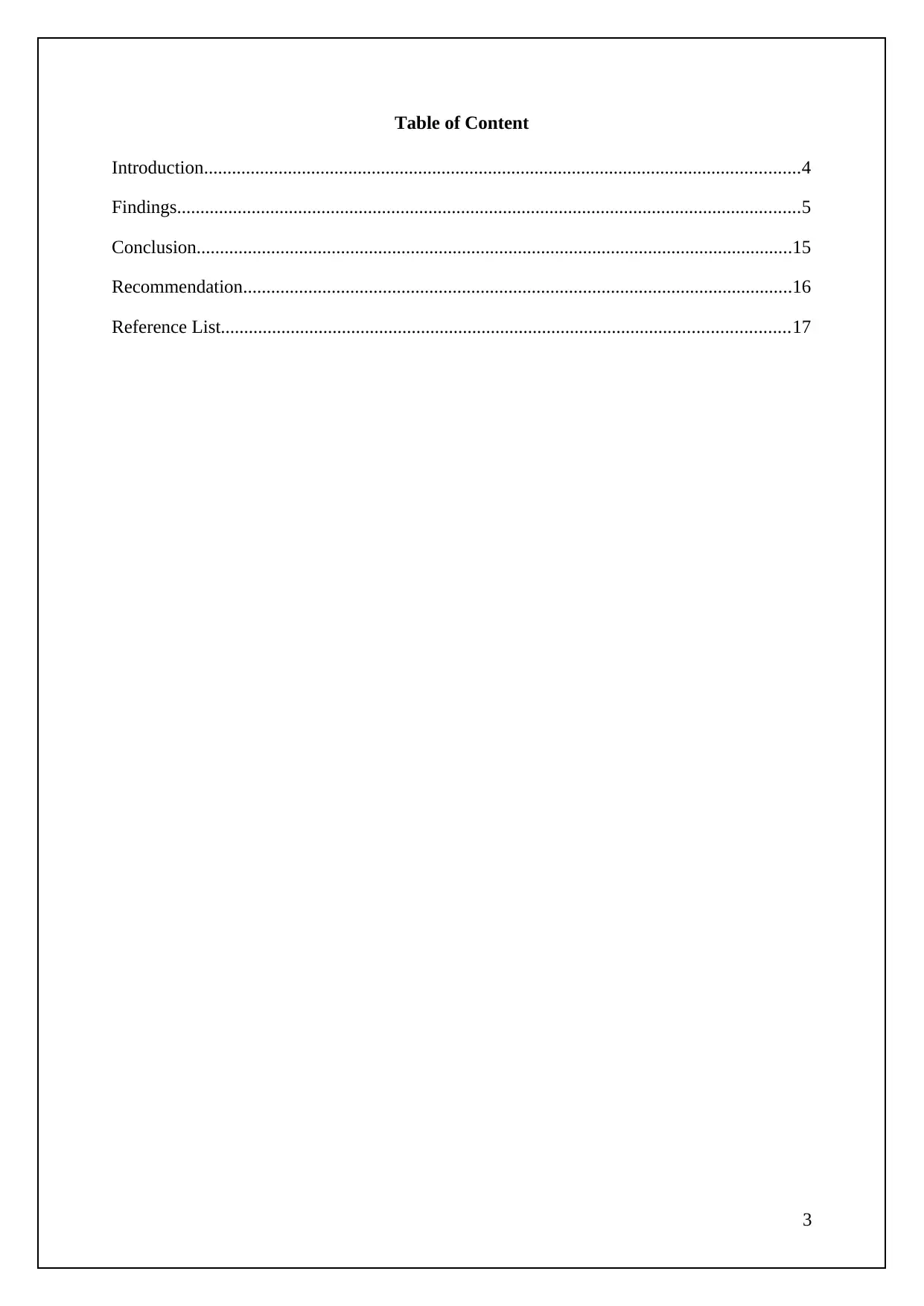
Table of Content
Introduction................................................................................................................................4
Findings......................................................................................................................................5
Conclusion................................................................................................................................15
Recommendation......................................................................................................................16
Reference List..........................................................................................................................17
3
Introduction................................................................................................................................4
Findings......................................................................................................................................5
Conclusion................................................................................................................................15
Recommendation......................................................................................................................16
Reference List..........................................................................................................................17
3
⊘ This is a preview!⊘
Do you want full access?
Subscribe today to unlock all pages.

Trusted by 1+ million students worldwide
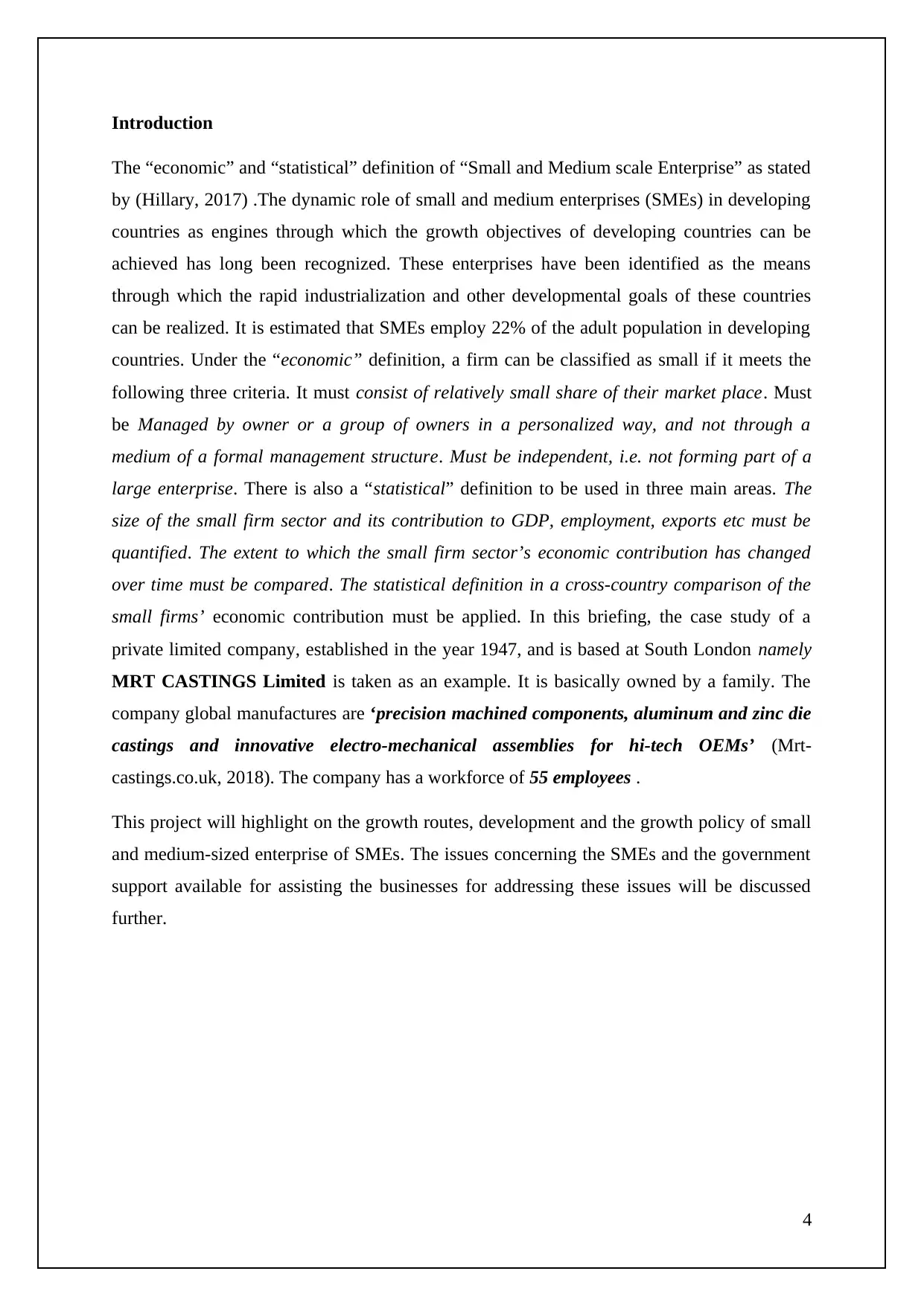
Introduction
The “economic” and “statistical” definition of “Small and Medium scale Enterprise” as stated
by (Hillary, 2017) .The dynamic role of small and medium enterprises (SMEs) in developing
countries as engines through which the growth objectives of developing countries can be
achieved has long been recognized. These enterprises have been identified as the means
through which the rapid industrialization and other developmental goals of these countries
can be realized. It is estimated that SMEs employ 22% of the adult population in developing
countries. Under the “economic” definition, a firm can be classified as small if it meets the
following three criteria. It must consist of relatively small share of their market place. Must
be Managed by owner or a group of owners in a personalized way, and not through a
medium of a formal management structure. Must be independent, i.e. not forming part of a
large enterprise. There is also a “statistical” definition to be used in three main areas. The
size of the small firm sector and its contribution to GDP, employment, exports etc must be
quantified. The extent to which the small firm sector’s economic contribution has changed
over time must be compared. The statistical definition in a cross-country comparison of the
small firms’ economic contribution must be applied. In this briefing, the case study of a
private limited company, established in the year 1947, and is based at South London namely
MRT CASTINGS Limited is taken as an example. It is basically owned by a family. The
company global manufactures are ‘precision machined components, aluminum and zinc die
castings and innovative electro-mechanical assemblies for hi-tech OEMs’ (Mrt-
castings.co.uk, 2018). The company has a workforce of 55 employees .
This project will highlight on the growth routes, development and the growth policy of small
and medium-sized enterprise of SMEs. The issues concerning the SMEs and the government
support available for assisting the businesses for addressing these issues will be discussed
further.
4
The “economic” and “statistical” definition of “Small and Medium scale Enterprise” as stated
by (Hillary, 2017) .The dynamic role of small and medium enterprises (SMEs) in developing
countries as engines through which the growth objectives of developing countries can be
achieved has long been recognized. These enterprises have been identified as the means
through which the rapid industrialization and other developmental goals of these countries
can be realized. It is estimated that SMEs employ 22% of the adult population in developing
countries. Under the “economic” definition, a firm can be classified as small if it meets the
following three criteria. It must consist of relatively small share of their market place. Must
be Managed by owner or a group of owners in a personalized way, and not through a
medium of a formal management structure. Must be independent, i.e. not forming part of a
large enterprise. There is also a “statistical” definition to be used in three main areas. The
size of the small firm sector and its contribution to GDP, employment, exports etc must be
quantified. The extent to which the small firm sector’s economic contribution has changed
over time must be compared. The statistical definition in a cross-country comparison of the
small firms’ economic contribution must be applied. In this briefing, the case study of a
private limited company, established in the year 1947, and is based at South London namely
MRT CASTINGS Limited is taken as an example. It is basically owned by a family. The
company global manufactures are ‘precision machined components, aluminum and zinc die
castings and innovative electro-mechanical assemblies for hi-tech OEMs’ (Mrt-
castings.co.uk, 2018). The company has a workforce of 55 employees .
This project will highlight on the growth routes, development and the growth policy of small
and medium-sized enterprise of SMEs. The issues concerning the SMEs and the government
support available for assisting the businesses for addressing these issues will be discussed
further.
4
Paraphrase This Document
Need a fresh take? Get an instant paraphrase of this document with our AI Paraphraser
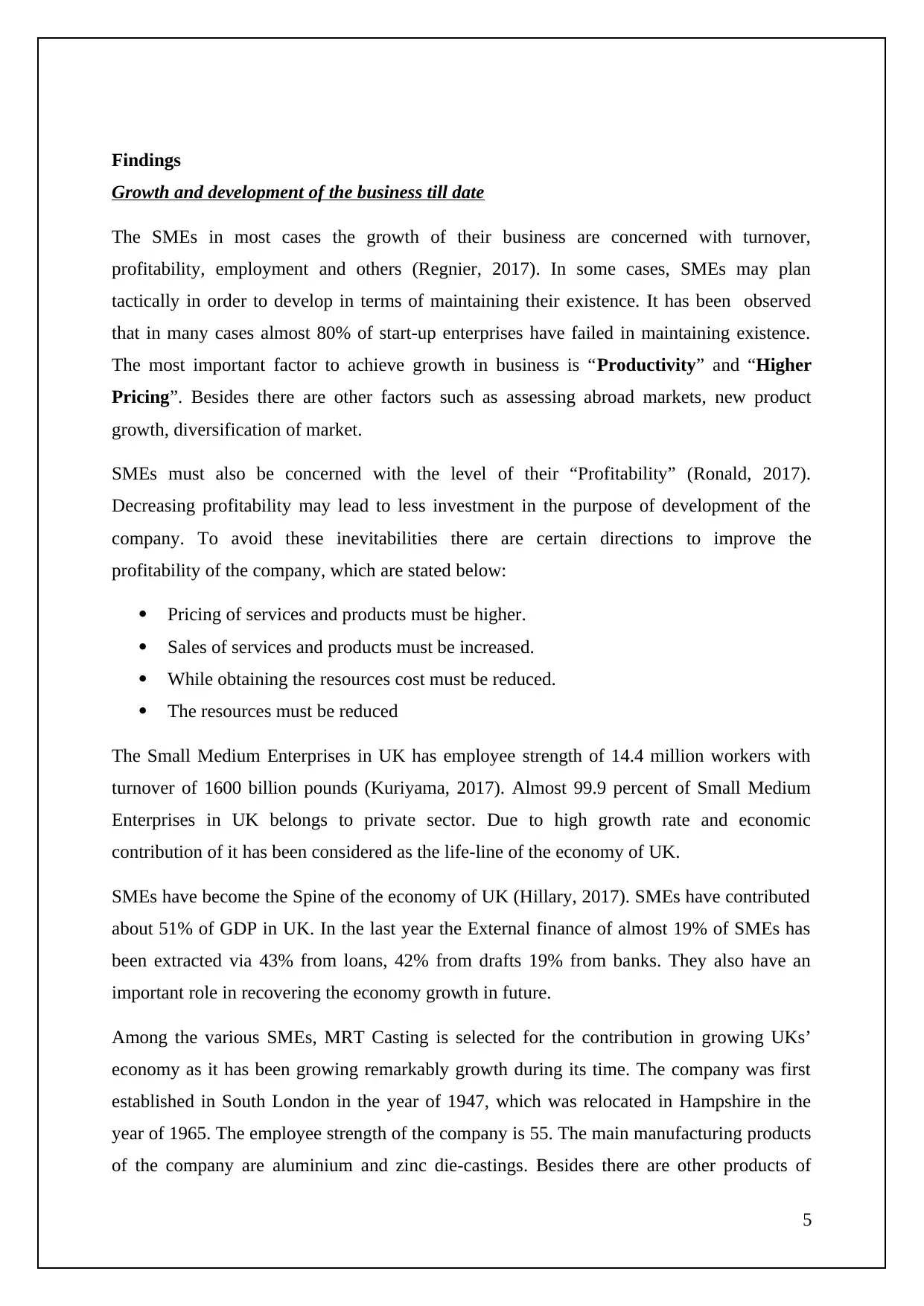
Findings
Growth and development of the business till date
The SMEs in most cases the growth of their business are concerned with turnover,
profitability, employment and others (Regnier, 2017). In some cases, SMEs may plan
tactically in order to develop in terms of maintaining their existence. It has been observed
that in many cases almost 80% of start-up enterprises have failed in maintaining existence.
The most important factor to achieve growth in business is “Productivity” and “Higher
Pricing”. Besides there are other factors such as assessing abroad markets, new product
growth, diversification of market.
SMEs must also be concerned with the level of their “Profitability” (Ronald, 2017).
Decreasing profitability may lead to less investment in the purpose of development of the
company. To avoid these inevitabilities there are certain directions to improve the
profitability of the company, which are stated below:
Pricing of services and products must be higher.
Sales of services and products must be increased.
While obtaining the resources cost must be reduced.
The resources must be reduced
The Small Medium Enterprises in UK has employee strength of 14.4 million workers with
turnover of 1600 billion pounds (Kuriyama, 2017). Almost 99.9 percent of Small Medium
Enterprises in UK belongs to private sector. Due to high growth rate and economic
contribution of it has been considered as the life-line of the economy of UK.
SMEs have become the Spine of the economy of UK (Hillary, 2017). SMEs have contributed
about 51% of GDP in UK. In the last year the External finance of almost 19% of SMEs has
been extracted via 43% from loans, 42% from drafts 19% from banks. They also have an
important role in recovering the economy growth in future.
Among the various SMEs, MRT Casting is selected for the contribution in growing UKs’
economy as it has been growing remarkably growth during its time. The company was first
established in South London in the year of 1947, which was relocated in Hampshire in the
year of 1965. The employee strength of the company is 55. The main manufacturing products
of the company are aluminium and zinc die-castings. Besides there are other products of
5
Growth and development of the business till date
The SMEs in most cases the growth of their business are concerned with turnover,
profitability, employment and others (Regnier, 2017). In some cases, SMEs may plan
tactically in order to develop in terms of maintaining their existence. It has been observed
that in many cases almost 80% of start-up enterprises have failed in maintaining existence.
The most important factor to achieve growth in business is “Productivity” and “Higher
Pricing”. Besides there are other factors such as assessing abroad markets, new product
growth, diversification of market.
SMEs must also be concerned with the level of their “Profitability” (Ronald, 2017).
Decreasing profitability may lead to less investment in the purpose of development of the
company. To avoid these inevitabilities there are certain directions to improve the
profitability of the company, which are stated below:
Pricing of services and products must be higher.
Sales of services and products must be increased.
While obtaining the resources cost must be reduced.
The resources must be reduced
The Small Medium Enterprises in UK has employee strength of 14.4 million workers with
turnover of 1600 billion pounds (Kuriyama, 2017). Almost 99.9 percent of Small Medium
Enterprises in UK belongs to private sector. Due to high growth rate and economic
contribution of it has been considered as the life-line of the economy of UK.
SMEs have become the Spine of the economy of UK (Hillary, 2017). SMEs have contributed
about 51% of GDP in UK. In the last year the External finance of almost 19% of SMEs has
been extracted via 43% from loans, 42% from drafts 19% from banks. They also have an
important role in recovering the economy growth in future.
Among the various SMEs, MRT Casting is selected for the contribution in growing UKs’
economy as it has been growing remarkably growth during its time. The company was first
established in South London in the year of 1947, which was relocated in Hampshire in the
year of 1965. The employee strength of the company is 55. The main manufacturing products
of the company are aluminium and zinc die-castings. Besides there are other products of
5
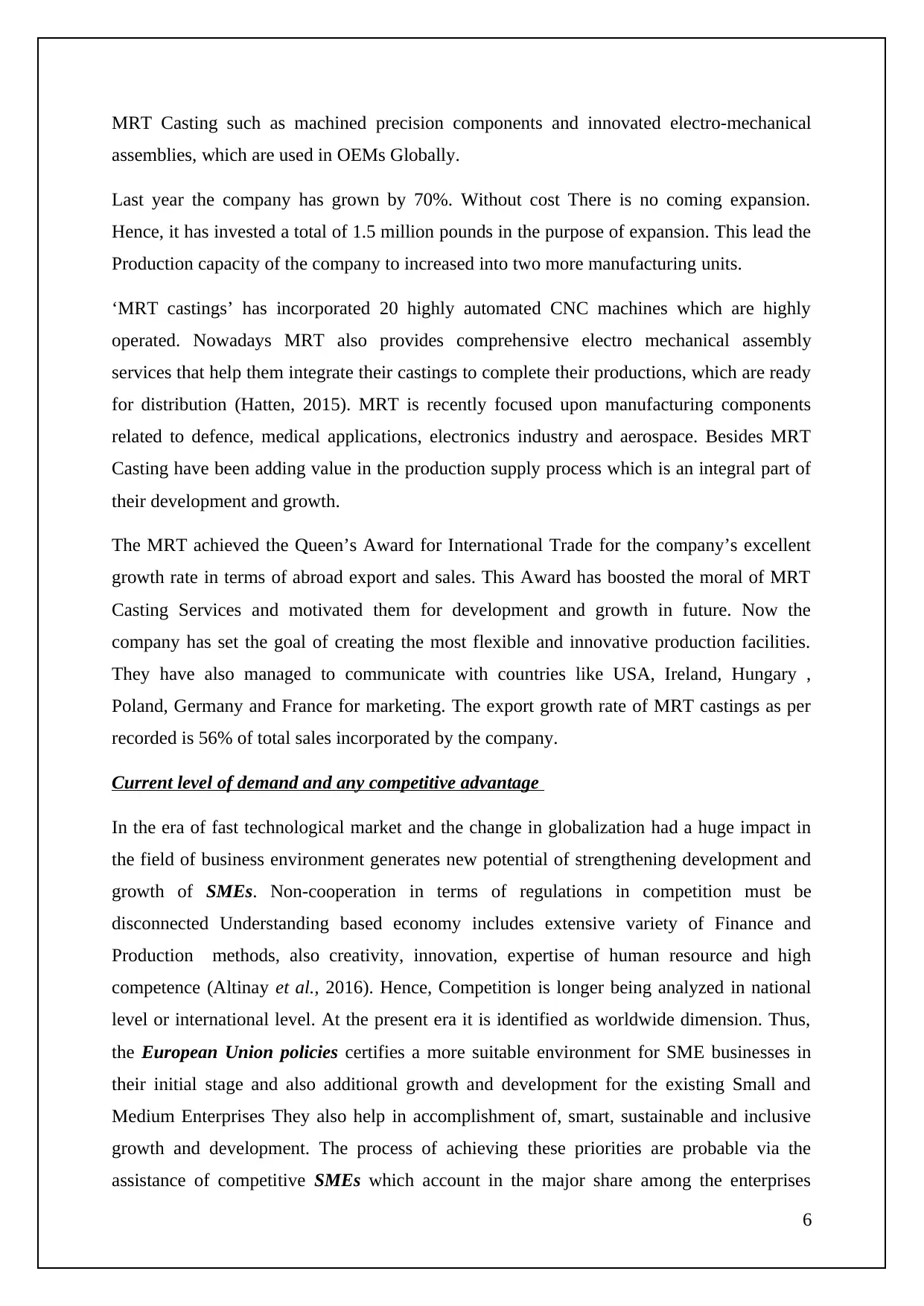
MRT Casting such as machined precision components and innovated electro-mechanical
assemblies, which are used in OEMs Globally.
Last year the company has grown by 70%. Without cost There is no coming expansion.
Hence, it has invested a total of 1.5 million pounds in the purpose of expansion. This lead the
Production capacity of the company to increased into two more manufacturing units.
‘MRT castings’ has incorporated 20 highly automated CNC machines which are highly
operated. Nowadays MRT also provides comprehensive electro mechanical assembly
services that help them integrate their castings to complete their productions, which are ready
for distribution (Hatten, 2015). MRT is recently focused upon manufacturing components
related to defence, medical applications, electronics industry and aerospace. Besides MRT
Casting have been adding value in the production supply process which is an integral part of
their development and growth.
The MRT achieved the Queen’s Award for International Trade for the company’s excellent
growth rate in terms of abroad export and sales. This Award has boosted the moral of MRT
Casting Services and motivated them for development and growth in future. Now the
company has set the goal of creating the most flexible and innovative production facilities.
They have also managed to communicate with countries like USA, Ireland, Hungary ,
Poland, Germany and France for marketing. The export growth rate of MRT castings as per
recorded is 56% of total sales incorporated by the company.
Current level of demand and any competitive advantage
In the era of fast technological market and the change in globalization had a huge impact in
the field of business environment generates new potential of strengthening development and
growth of SMEs. Non-cooperation in terms of regulations in competition must be
disconnected Understanding based economy includes extensive variety of Finance and
Production methods, also creativity, innovation, expertise of human resource and high
competence (Altinay et al., 2016). Hence, Competition is longer being analyzed in national
level or international level. At the present era it is identified as worldwide dimension. Thus,
the European Union policies certifies a more suitable environment for SME businesses in
their initial stage and also additional growth and development for the existing Small and
Medium Enterprises They also help in accomplishment of, smart, sustainable and inclusive
growth and development. The process of achieving these priorities are probable via the
assistance of competitive SMEs which account in the major share among the enterprises
6
assemblies, which are used in OEMs Globally.
Last year the company has grown by 70%. Without cost There is no coming expansion.
Hence, it has invested a total of 1.5 million pounds in the purpose of expansion. This lead the
Production capacity of the company to increased into two more manufacturing units.
‘MRT castings’ has incorporated 20 highly automated CNC machines which are highly
operated. Nowadays MRT also provides comprehensive electro mechanical assembly
services that help them integrate their castings to complete their productions, which are ready
for distribution (Hatten, 2015). MRT is recently focused upon manufacturing components
related to defence, medical applications, electronics industry and aerospace. Besides MRT
Casting have been adding value in the production supply process which is an integral part of
their development and growth.
The MRT achieved the Queen’s Award for International Trade for the company’s excellent
growth rate in terms of abroad export and sales. This Award has boosted the moral of MRT
Casting Services and motivated them for development and growth in future. Now the
company has set the goal of creating the most flexible and innovative production facilities.
They have also managed to communicate with countries like USA, Ireland, Hungary ,
Poland, Germany and France for marketing. The export growth rate of MRT castings as per
recorded is 56% of total sales incorporated by the company.
Current level of demand and any competitive advantage
In the era of fast technological market and the change in globalization had a huge impact in
the field of business environment generates new potential of strengthening development and
growth of SMEs. Non-cooperation in terms of regulations in competition must be
disconnected Understanding based economy includes extensive variety of Finance and
Production methods, also creativity, innovation, expertise of human resource and high
competence (Altinay et al., 2016). Hence, Competition is longer being analyzed in national
level or international level. At the present era it is identified as worldwide dimension. Thus,
the European Union policies certifies a more suitable environment for SME businesses in
their initial stage and also additional growth and development for the existing Small and
Medium Enterprises They also help in accomplishment of, smart, sustainable and inclusive
growth and development. The process of achieving these priorities are probable via the
assistance of competitive SMEs which account in the major share among the enterprises
6
⊘ This is a preview!⊘
Do you want full access?
Subscribe today to unlock all pages.

Trusted by 1+ million students worldwide
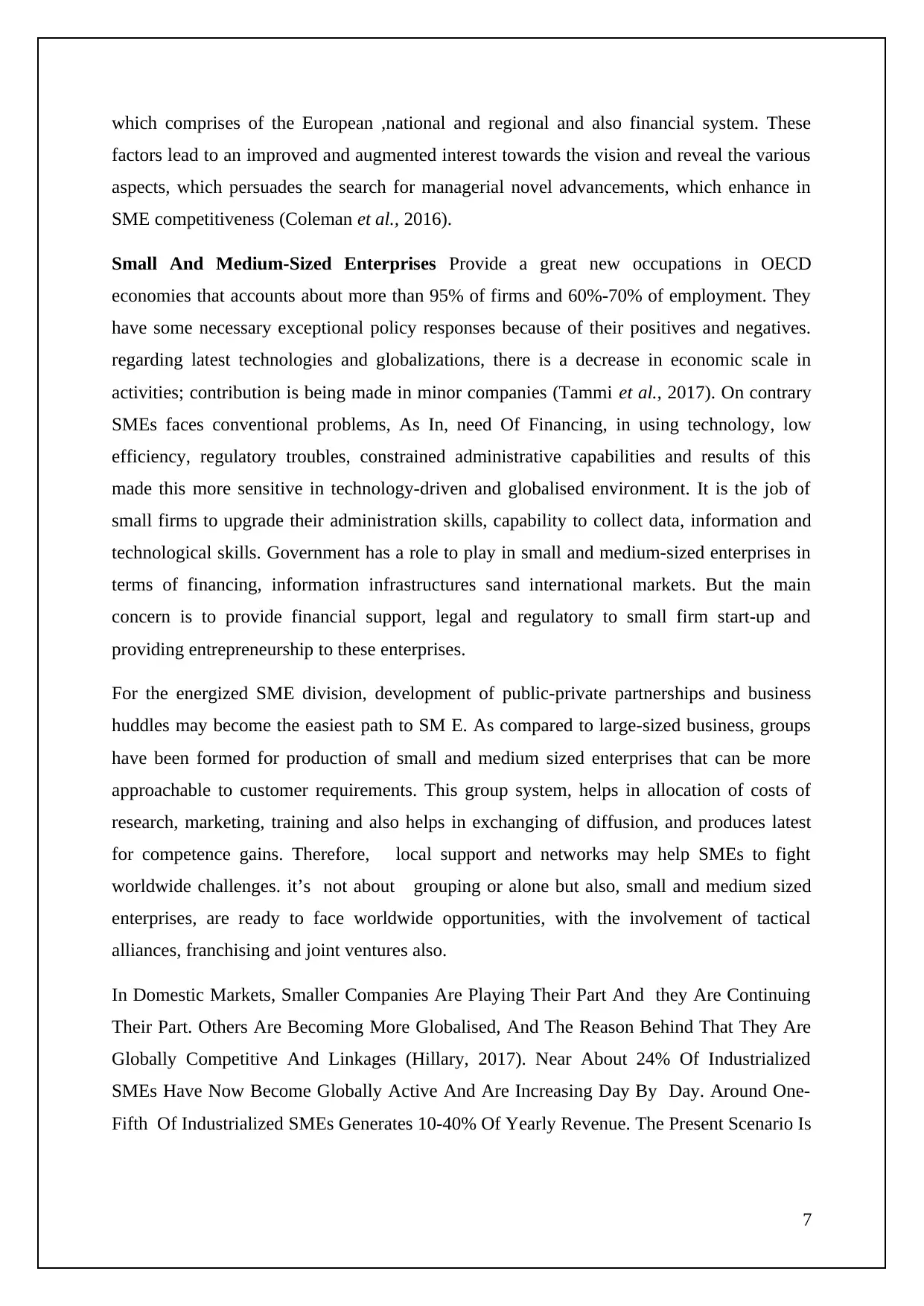
which comprises of the European ,national and regional and also financial system. These
factors lead to an improved and augmented interest towards the vision and reveal the various
aspects, which persuades the search for managerial novel advancements, which enhance in
SME competitiveness (Coleman et al., 2016).
Small And Medium-Sized Enterprises Provide a great new occupations in OECD
economies that accounts about more than 95% of firms and 60%-70% of employment. They
have some necessary exceptional policy responses because of their positives and negatives.
regarding latest technologies and globalizations, there is a decrease in economic scale in
activities; contribution is being made in minor companies (Tammi et al., 2017). On contrary
SMEs faces conventional problems, As In, need Of Financing, in using technology, low
efficiency, regulatory troubles, constrained administrative capabilities and results of this
made this more sensitive in technology-driven and globalised environment. It is the job of
small firms to upgrade their administration skills, capability to collect data, information and
technological skills. Government has a role to play in small and medium-sized enterprises in
terms of financing, information infrastructures sand international markets. But the main
concern is to provide financial support, legal and regulatory to small firm start-up and
providing entrepreneurship to these enterprises.
For the energized SME division, development of public-private partnerships and business
huddles may become the easiest path to SM E. As compared to large-sized business, groups
have been formed for production of small and medium sized enterprises that can be more
approachable to customer requirements. This group system, helps in allocation of costs of
research, marketing, training and also helps in exchanging of diffusion, and produces latest
for competence gains. Therefore, local support and networks may help SMEs to fight
worldwide challenges. it’s not about grouping or alone but also, small and medium sized
enterprises, are ready to face worldwide opportunities, with the involvement of tactical
alliances, franchising and joint ventures also.
In Domestic Markets, Smaller Companies Are Playing Their Part And they Are Continuing
Their Part. Others Are Becoming More Globalised, And The Reason Behind That They Are
Globally Competitive And Linkages (Hillary, 2017). Near About 24% Of Industrialized
SMEs Have Now Become Globally Active And Are Increasing Day By Day. Around One-
Fifth Of Industrialized SMEs Generates 10-40% Of Yearly Revenue. The Present Scenario Is
7
factors lead to an improved and augmented interest towards the vision and reveal the various
aspects, which persuades the search for managerial novel advancements, which enhance in
SME competitiveness (Coleman et al., 2016).
Small And Medium-Sized Enterprises Provide a great new occupations in OECD
economies that accounts about more than 95% of firms and 60%-70% of employment. They
have some necessary exceptional policy responses because of their positives and negatives.
regarding latest technologies and globalizations, there is a decrease in economic scale in
activities; contribution is being made in minor companies (Tammi et al., 2017). On contrary
SMEs faces conventional problems, As In, need Of Financing, in using technology, low
efficiency, regulatory troubles, constrained administrative capabilities and results of this
made this more sensitive in technology-driven and globalised environment. It is the job of
small firms to upgrade their administration skills, capability to collect data, information and
technological skills. Government has a role to play in small and medium-sized enterprises in
terms of financing, information infrastructures sand international markets. But the main
concern is to provide financial support, legal and regulatory to small firm start-up and
providing entrepreneurship to these enterprises.
For the energized SME division, development of public-private partnerships and business
huddles may become the easiest path to SM E. As compared to large-sized business, groups
have been formed for production of small and medium sized enterprises that can be more
approachable to customer requirements. This group system, helps in allocation of costs of
research, marketing, training and also helps in exchanging of diffusion, and produces latest
for competence gains. Therefore, local support and networks may help SMEs to fight
worldwide challenges. it’s not about grouping or alone but also, small and medium sized
enterprises, are ready to face worldwide opportunities, with the involvement of tactical
alliances, franchising and joint ventures also.
In Domestic Markets, Smaller Companies Are Playing Their Part And they Are Continuing
Their Part. Others Are Becoming More Globalised, And The Reason Behind That They Are
Globally Competitive And Linkages (Hillary, 2017). Near About 24% Of Industrialized
SMEs Have Now Become Globally Active And Are Increasing Day By Day. Around One-
Fifth Of Industrialized SMEs Generates 10-40% Of Yearly Revenue. The Present Scenario Is
7
Paraphrase This Document
Need a fresh take? Get an instant paraphrase of this document with our AI Paraphraser
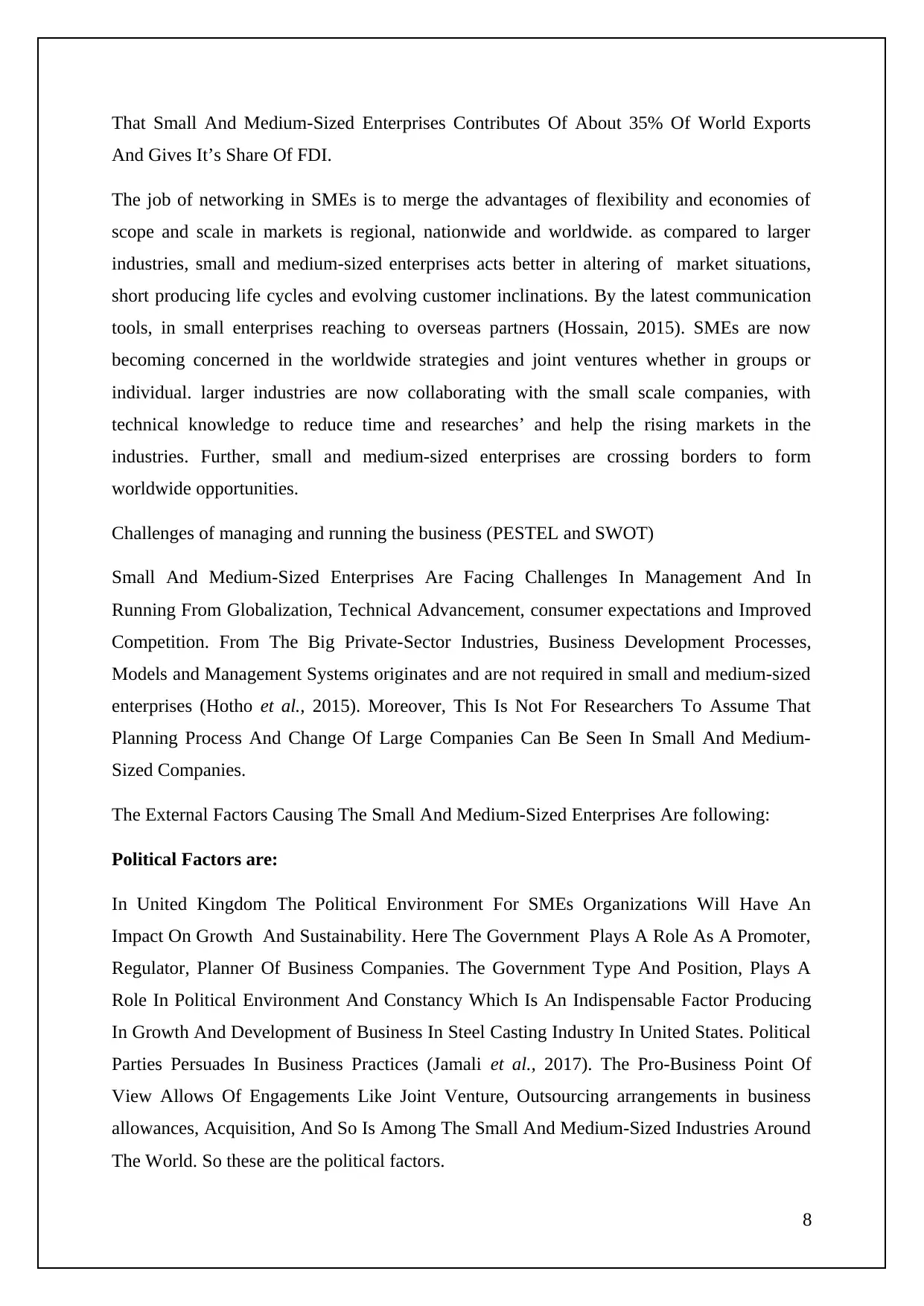
That Small And Medium-Sized Enterprises Contributes Of About 35% Of World Exports
And Gives It’s Share Of FDI.
The job of networking in SMEs is to merge the advantages of flexibility and economies of
scope and scale in markets is regional, nationwide and worldwide. as compared to larger
industries, small and medium-sized enterprises acts better in altering of market situations,
short producing life cycles and evolving customer inclinations. By the latest communication
tools, in small enterprises reaching to overseas partners (Hossain, 2015). SMEs are now
becoming concerned in the worldwide strategies and joint ventures whether in groups or
individual. larger industries are now collaborating with the small scale companies, with
technical knowledge to reduce time and researches’ and help the rising markets in the
industries. Further, small and medium-sized enterprises are crossing borders to form
worldwide opportunities.
Challenges of managing and running the business (PESTEL and SWOT)
Small And Medium-Sized Enterprises Are Facing Challenges In Management And In
Running From Globalization, Technical Advancement, consumer expectations and Improved
Competition. From The Big Private-Sector Industries, Business Development Processes,
Models and Management Systems originates and are not required in small and medium-sized
enterprises (Hotho et al., 2015). Moreover, This Is Not For Researchers To Assume That
Planning Process And Change Of Large Companies Can Be Seen In Small And Medium-
Sized Companies.
The External Factors Causing The Small And Medium-Sized Enterprises Are following:
Political Factors are:
In United Kingdom The Political Environment For SMEs Organizations Will Have An
Impact On Growth And Sustainability. Here The Government Plays A Role As A Promoter,
Regulator, Planner Of Business Companies. The Government Type And Position, Plays A
Role In Political Environment And Constancy Which Is An Indispensable Factor Producing
In Growth And Development of Business In Steel Casting Industry In United States. Political
Parties Persuades In Business Practices (Jamali et al., 2017). The Pro-Business Point Of
View Allows Of Engagements Like Joint Venture, Outsourcing arrangements in business
allowances, Acquisition, And So Is Among The Small And Medium-Sized Industries Around
The World. So these are the political factors.
8
And Gives It’s Share Of FDI.
The job of networking in SMEs is to merge the advantages of flexibility and economies of
scope and scale in markets is regional, nationwide and worldwide. as compared to larger
industries, small and medium-sized enterprises acts better in altering of market situations,
short producing life cycles and evolving customer inclinations. By the latest communication
tools, in small enterprises reaching to overseas partners (Hossain, 2015). SMEs are now
becoming concerned in the worldwide strategies and joint ventures whether in groups or
individual. larger industries are now collaborating with the small scale companies, with
technical knowledge to reduce time and researches’ and help the rising markets in the
industries. Further, small and medium-sized enterprises are crossing borders to form
worldwide opportunities.
Challenges of managing and running the business (PESTEL and SWOT)
Small And Medium-Sized Enterprises Are Facing Challenges In Management And In
Running From Globalization, Technical Advancement, consumer expectations and Improved
Competition. From The Big Private-Sector Industries, Business Development Processes,
Models and Management Systems originates and are not required in small and medium-sized
enterprises (Hotho et al., 2015). Moreover, This Is Not For Researchers To Assume That
Planning Process And Change Of Large Companies Can Be Seen In Small And Medium-
Sized Companies.
The External Factors Causing The Small And Medium-Sized Enterprises Are following:
Political Factors are:
In United Kingdom The Political Environment For SMEs Organizations Will Have An
Impact On Growth And Sustainability. Here The Government Plays A Role As A Promoter,
Regulator, Planner Of Business Companies. The Government Type And Position, Plays A
Role In Political Environment And Constancy Which Is An Indispensable Factor Producing
In Growth And Development of Business In Steel Casting Industry In United States. Political
Parties Persuades In Business Practices (Jamali et al., 2017). The Pro-Business Point Of
View Allows Of Engagements Like Joint Venture, Outsourcing arrangements in business
allowances, Acquisition, And So Is Among The Small And Medium-Sized Industries Around
The World. So these are the political factors.
8
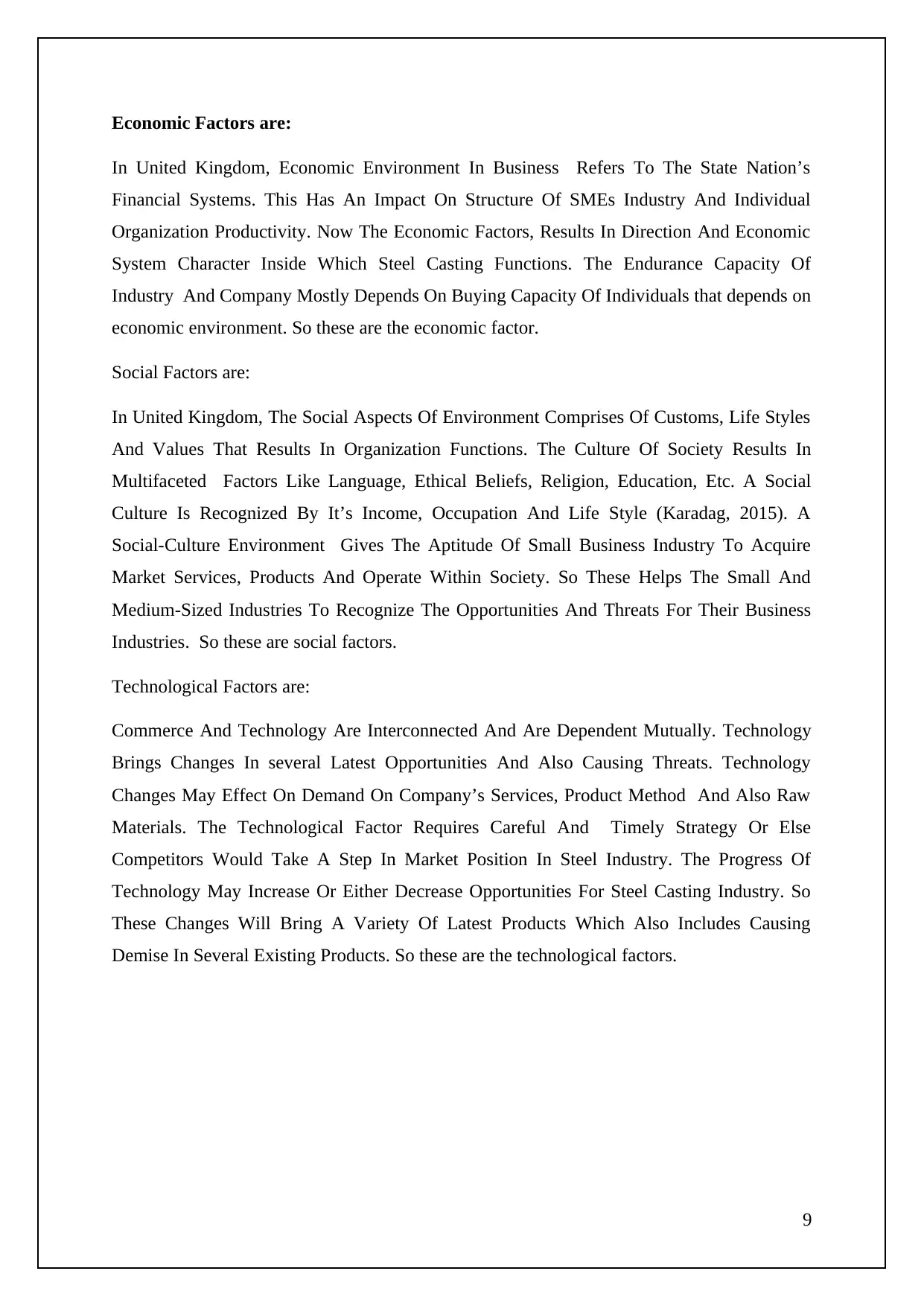
Economic Factors are:
In United Kingdom, Economic Environment In Business Refers To The State Nation’s
Financial Systems. This Has An Impact On Structure Of SMEs Industry And Individual
Organization Productivity. Now The Economic Factors, Results In Direction And Economic
System Character Inside Which Steel Casting Functions. The Endurance Capacity Of
Industry And Company Mostly Depends On Buying Capacity Of Individuals that depends on
economic environment. So these are the economic factor.
Social Factors are:
In United Kingdom, The Social Aspects Of Environment Comprises Of Customs, Life Styles
And Values That Results In Organization Functions. The Culture Of Society Results In
Multifaceted Factors Like Language, Ethical Beliefs, Religion, Education, Etc. A Social
Culture Is Recognized By It’s Income, Occupation And Life Style (Karadag, 2015). A
Social-Culture Environment Gives The Aptitude Of Small Business Industry To Acquire
Market Services, Products And Operate Within Society. So These Helps The Small And
Medium-Sized Industries To Recognize The Opportunities And Threats For Their Business
Industries. So these are social factors.
Technological Factors are:
Commerce And Technology Are Interconnected And Are Dependent Mutually. Technology
Brings Changes In several Latest Opportunities And Also Causing Threats. Technology
Changes May Effect On Demand On Company’s Services, Product Method And Also Raw
Materials. The Technological Factor Requires Careful And Timely Strategy Or Else
Competitors Would Take A Step In Market Position In Steel Industry. The Progress Of
Technology May Increase Or Either Decrease Opportunities For Steel Casting Industry. So
These Changes Will Bring A Variety Of Latest Products Which Also Includes Causing
Demise In Several Existing Products. So these are the technological factors.
9
In United Kingdom, Economic Environment In Business Refers To The State Nation’s
Financial Systems. This Has An Impact On Structure Of SMEs Industry And Individual
Organization Productivity. Now The Economic Factors, Results In Direction And Economic
System Character Inside Which Steel Casting Functions. The Endurance Capacity Of
Industry And Company Mostly Depends On Buying Capacity Of Individuals that depends on
economic environment. So these are the economic factor.
Social Factors are:
In United Kingdom, The Social Aspects Of Environment Comprises Of Customs, Life Styles
And Values That Results In Organization Functions. The Culture Of Society Results In
Multifaceted Factors Like Language, Ethical Beliefs, Religion, Education, Etc. A Social
Culture Is Recognized By It’s Income, Occupation And Life Style (Karadag, 2015). A
Social-Culture Environment Gives The Aptitude Of Small Business Industry To Acquire
Market Services, Products And Operate Within Society. So These Helps The Small And
Medium-Sized Industries To Recognize The Opportunities And Threats For Their Business
Industries. So these are social factors.
Technological Factors are:
Commerce And Technology Are Interconnected And Are Dependent Mutually. Technology
Brings Changes In several Latest Opportunities And Also Causing Threats. Technology
Changes May Effect On Demand On Company’s Services, Product Method And Also Raw
Materials. The Technological Factor Requires Careful And Timely Strategy Or Else
Competitors Would Take A Step In Market Position In Steel Industry. The Progress Of
Technology May Increase Or Either Decrease Opportunities For Steel Casting Industry. So
These Changes Will Bring A Variety Of Latest Products Which Also Includes Causing
Demise In Several Existing Products. So these are the technological factors.
9
⊘ This is a preview!⊘
Do you want full access?
Subscribe today to unlock all pages.

Trusted by 1+ million students worldwide
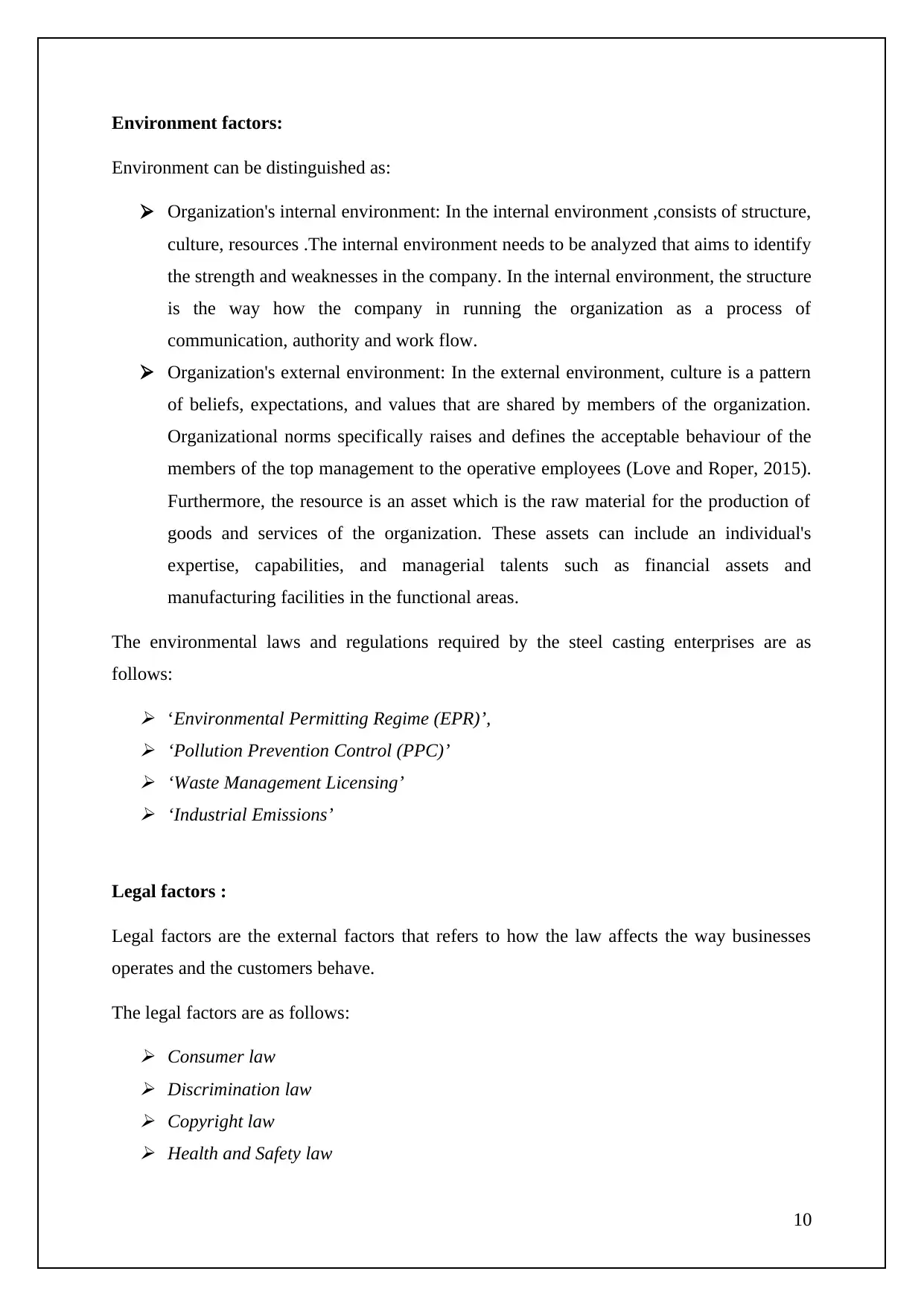
Environment factors:
Environment can be distinguished as:
Organization's internal environment: In the internal environment ,consists of structure,
culture, resources .The internal environment needs to be analyzed that aims to identify
the strength and weaknesses in the company. In the internal environment, the structure
is the way how the company in running the organization as a process of
communication, authority and work flow.
Organization's external environment: In the external environment, culture is a pattern
of beliefs, expectations, and values that are shared by members of the organization.
Organizational norms specifically raises and defines the acceptable behaviour of the
members of the top management to the operative employees (Love and Roper, 2015).
Furthermore, the resource is an asset which is the raw material for the production of
goods and services of the organization. These assets can include an individual's
expertise, capabilities, and managerial talents such as financial assets and
manufacturing facilities in the functional areas.
The environmental laws and regulations required by the steel casting enterprises are as
follows: ‘Environmental Permitting Regime (EPR)’, ‘Pollution Prevention Control (PPC)’ ‘Waste Management Licensing’ ‘Industrial Emissions’
Legal factors :
Legal factors are the external factors that refers to how the law affects the way businesses
operates and the customers behave.
The legal factors are as follows: Consumer law Discrimination law Copyright law Health and Safety law
10
Environment can be distinguished as:
Organization's internal environment: In the internal environment ,consists of structure,
culture, resources .The internal environment needs to be analyzed that aims to identify
the strength and weaknesses in the company. In the internal environment, the structure
is the way how the company in running the organization as a process of
communication, authority and work flow.
Organization's external environment: In the external environment, culture is a pattern
of beliefs, expectations, and values that are shared by members of the organization.
Organizational norms specifically raises and defines the acceptable behaviour of the
members of the top management to the operative employees (Love and Roper, 2015).
Furthermore, the resource is an asset which is the raw material for the production of
goods and services of the organization. These assets can include an individual's
expertise, capabilities, and managerial talents such as financial assets and
manufacturing facilities in the functional areas.
The environmental laws and regulations required by the steel casting enterprises are as
follows: ‘Environmental Permitting Regime (EPR)’, ‘Pollution Prevention Control (PPC)’ ‘Waste Management Licensing’ ‘Industrial Emissions’
Legal factors :
Legal factors are the external factors that refers to how the law affects the way businesses
operates and the customers behave.
The legal factors are as follows: Consumer law Discrimination law Copyright law Health and Safety law
10
Paraphrase This Document
Need a fresh take? Get an instant paraphrase of this document with our AI Paraphraser
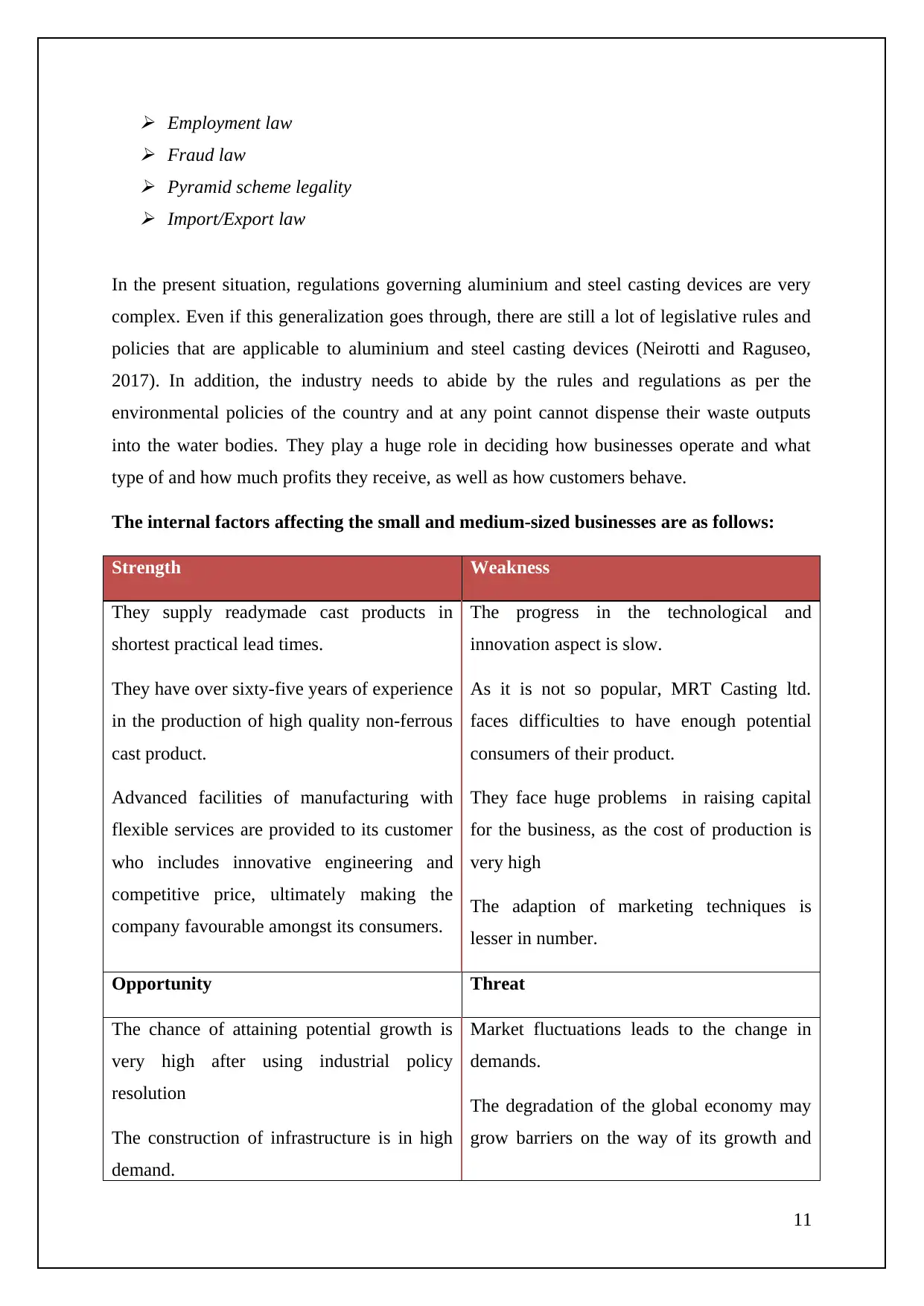
Employment law Fraud law Pyramid scheme legality Import/Export law
In the present situation, regulations governing aluminium and steel casting devices are very
complex. Even if this generalization goes through, there are still a lot of legislative rules and
policies that are applicable to aluminium and steel casting devices (Neirotti and Raguseo,
2017). In addition, the industry needs to abide by the rules and regulations as per the
environmental policies of the country and at any point cannot dispense their waste outputs
into the water bodies. They play a huge role in deciding how businesses operate and what
type of and how much profits they receive, as well as how customers behave.
The internal factors affecting the small and medium-sized businesses are as follows:
Strength Weakness
They supply readymade cast products in
shortest practical lead times.
They have over sixty-five years of experience
in the production of high quality non-ferrous
cast product.
Advanced facilities of manufacturing with
flexible services are provided to its customer
who includes innovative engineering and
competitive price, ultimately making the
company favourable amongst its consumers.
The progress in the technological and
innovation aspect is slow.
As it is not so popular, MRT Casting ltd.
faces difficulties to have enough potential
consumers of their product.
They face huge problems in raising capital
for the business, as the cost of production is
very high
The adaption of marketing techniques is
lesser in number.
Opportunity Threat
The chance of attaining potential growth is
very high after using industrial policy
resolution
The construction of infrastructure is in high
demand.
Market fluctuations leads to the change in
demands.
The degradation of the global economy may
grow barriers on the way of its growth and
11
In the present situation, regulations governing aluminium and steel casting devices are very
complex. Even if this generalization goes through, there are still a lot of legislative rules and
policies that are applicable to aluminium and steel casting devices (Neirotti and Raguseo,
2017). In addition, the industry needs to abide by the rules and regulations as per the
environmental policies of the country and at any point cannot dispense their waste outputs
into the water bodies. They play a huge role in deciding how businesses operate and what
type of and how much profits they receive, as well as how customers behave.
The internal factors affecting the small and medium-sized businesses are as follows:
Strength Weakness
They supply readymade cast products in
shortest practical lead times.
They have over sixty-five years of experience
in the production of high quality non-ferrous
cast product.
Advanced facilities of manufacturing with
flexible services are provided to its customer
who includes innovative engineering and
competitive price, ultimately making the
company favourable amongst its consumers.
The progress in the technological and
innovation aspect is slow.
As it is not so popular, MRT Casting ltd.
faces difficulties to have enough potential
consumers of their product.
They face huge problems in raising capital
for the business, as the cost of production is
very high
The adaption of marketing techniques is
lesser in number.
Opportunity Threat
The chance of attaining potential growth is
very high after using industrial policy
resolution
The construction of infrastructure is in high
demand.
Market fluctuations leads to the change in
demands.
The degradation of the global economy may
grow barriers on the way of its growth and
11
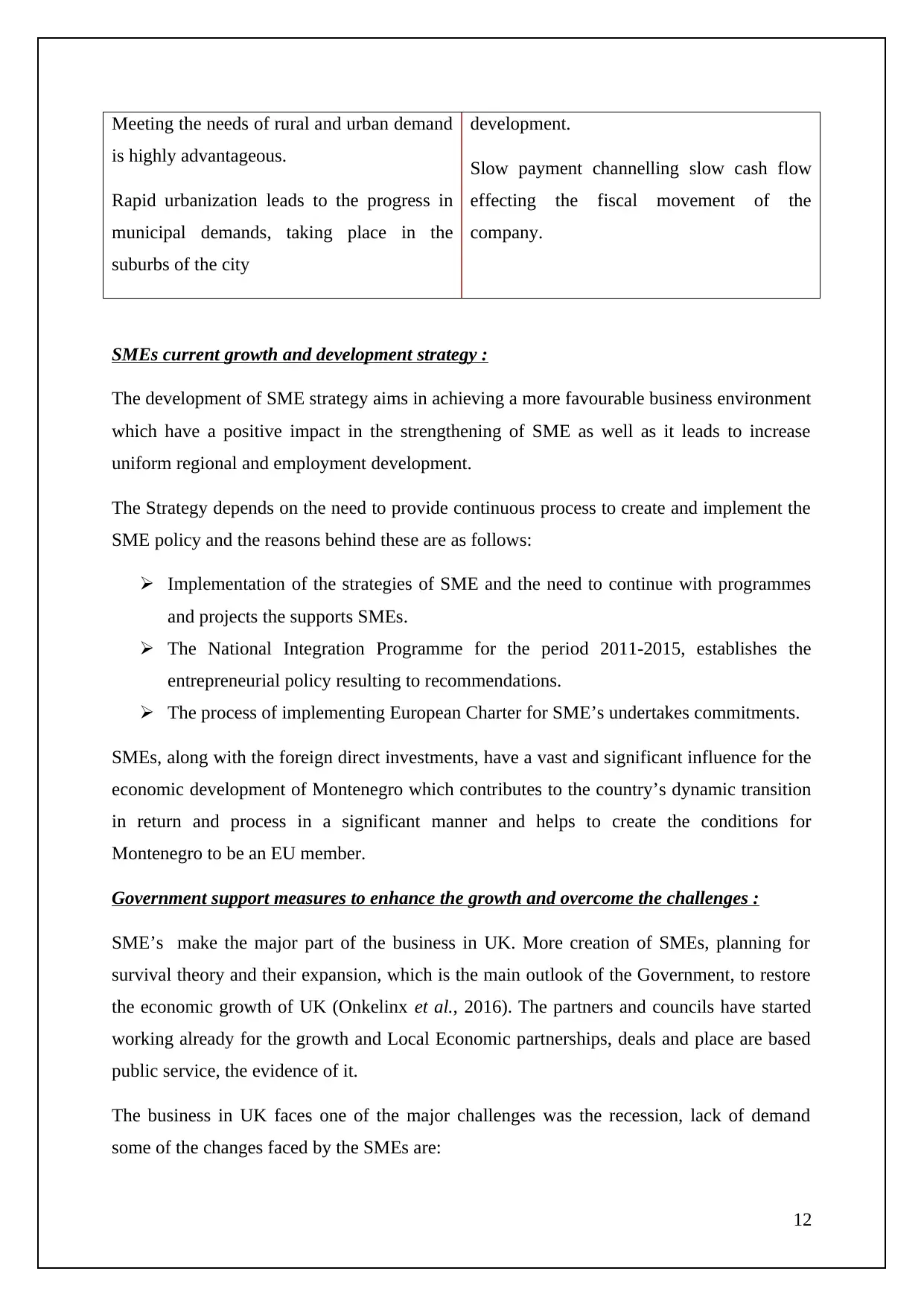
Meeting the needs of rural and urban demand
is highly advantageous.
Rapid urbanization leads to the progress in
municipal demands, taking place in the
suburbs of the city
development.
Slow payment channelling slow cash flow
effecting the fiscal movement of the
company.
SMEs current growth and development strategy :
The development of SME strategy aims in achieving a more favourable business environment
which have a positive impact in the strengthening of SME as well as it leads to increase
uniform regional and employment development.
The Strategy depends on the need to provide continuous process to create and implement the
SME policy and the reasons behind these are as follows:
Implementation of the strategies of SME and the need to continue with programmes
and projects the supports SMEs.
The National Integration Programme for the period 2011-2015, establishes the
entrepreneurial policy resulting to recommendations.
The process of implementing European Charter for SME’s undertakes commitments.
SMEs, along with the foreign direct investments, have a vast and significant influence for the
economic development of Montenegro which contributes to the country’s dynamic transition
in return and process in a significant manner and helps to create the conditions for
Montenegro to be an EU member.
Government support measures to enhance the growth and overcome the challenges :
SME’s make the major part of the business in UK. More creation of SMEs, planning for
survival theory and their expansion, which is the main outlook of the Government, to restore
the economic growth of UK (Onkelinx et al., 2016). The partners and councils have started
working already for the growth and Local Economic partnerships, deals and place are based
public service, the evidence of it.
The business in UK faces one of the major challenges was the recession, lack of demand
some of the changes faced by the SMEs are:
12
is highly advantageous.
Rapid urbanization leads to the progress in
municipal demands, taking place in the
suburbs of the city
development.
Slow payment channelling slow cash flow
effecting the fiscal movement of the
company.
SMEs current growth and development strategy :
The development of SME strategy aims in achieving a more favourable business environment
which have a positive impact in the strengthening of SME as well as it leads to increase
uniform regional and employment development.
The Strategy depends on the need to provide continuous process to create and implement the
SME policy and the reasons behind these are as follows:
Implementation of the strategies of SME and the need to continue with programmes
and projects the supports SMEs.
The National Integration Programme for the period 2011-2015, establishes the
entrepreneurial policy resulting to recommendations.
The process of implementing European Charter for SME’s undertakes commitments.
SMEs, along with the foreign direct investments, have a vast and significant influence for the
economic development of Montenegro which contributes to the country’s dynamic transition
in return and process in a significant manner and helps to create the conditions for
Montenegro to be an EU member.
Government support measures to enhance the growth and overcome the challenges :
SME’s make the major part of the business in UK. More creation of SMEs, planning for
survival theory and their expansion, which is the main outlook of the Government, to restore
the economic growth of UK (Onkelinx et al., 2016). The partners and councils have started
working already for the growth and Local Economic partnerships, deals and place are based
public service, the evidence of it.
The business in UK faces one of the major challenges was the recession, lack of demand
some of the changes faced by the SMEs are:
12
⊘ This is a preview!⊘
Do you want full access?
Subscribe today to unlock all pages.

Trusted by 1+ million students worldwide
1 out of 16
Related Documents
Your All-in-One AI-Powered Toolkit for Academic Success.
+13062052269
info@desklib.com
Available 24*7 on WhatsApp / Email
![[object Object]](/_next/static/media/star-bottom.7253800d.svg)
Unlock your academic potential
Copyright © 2020–2025 A2Z Services. All Rights Reserved. Developed and managed by ZUCOL.





